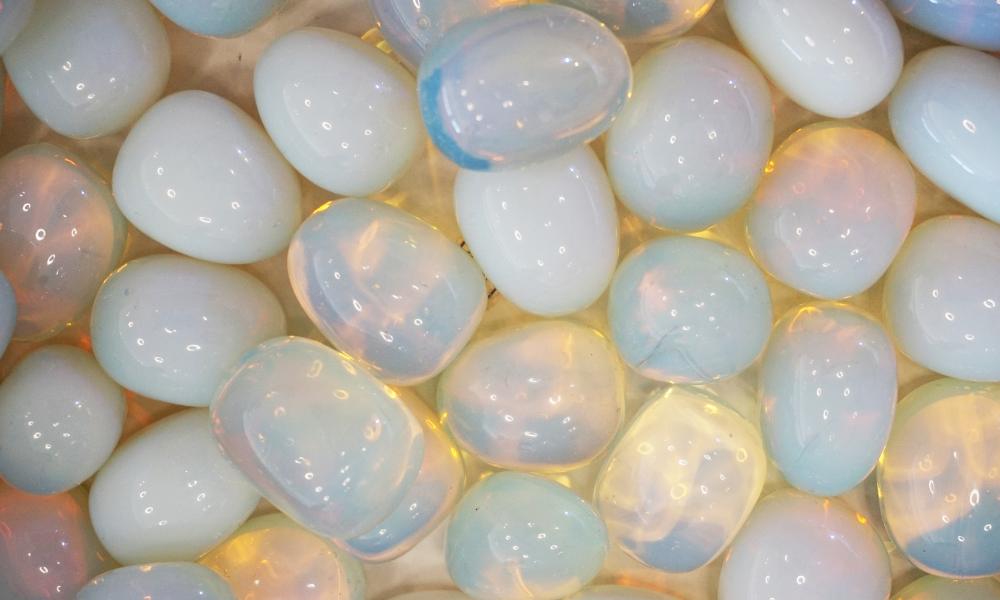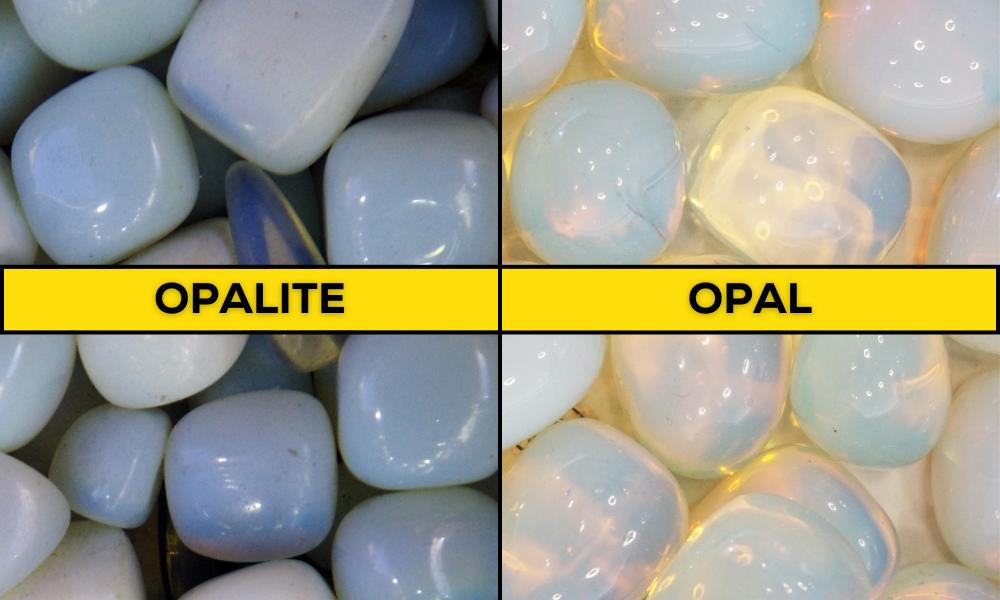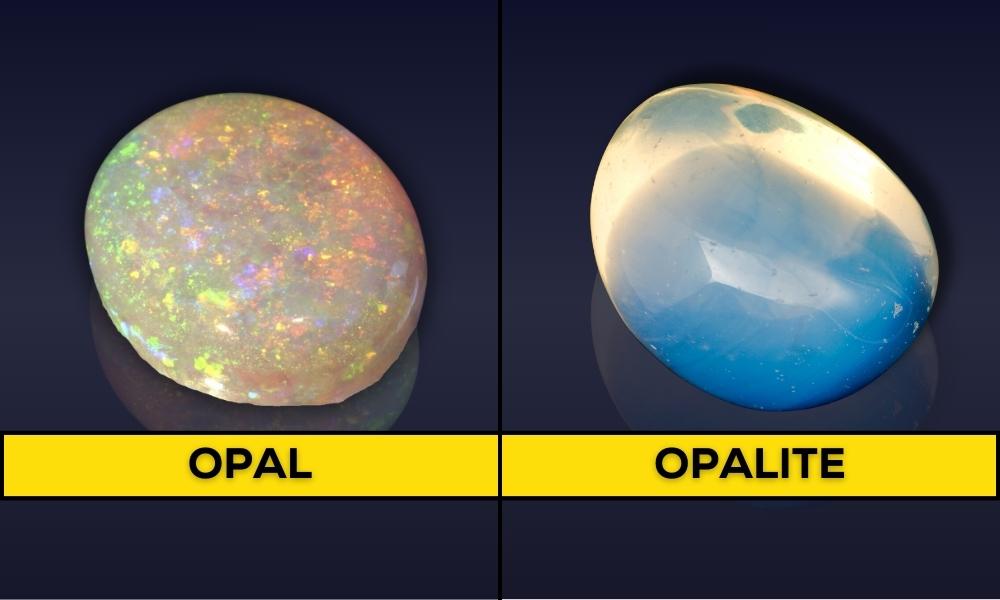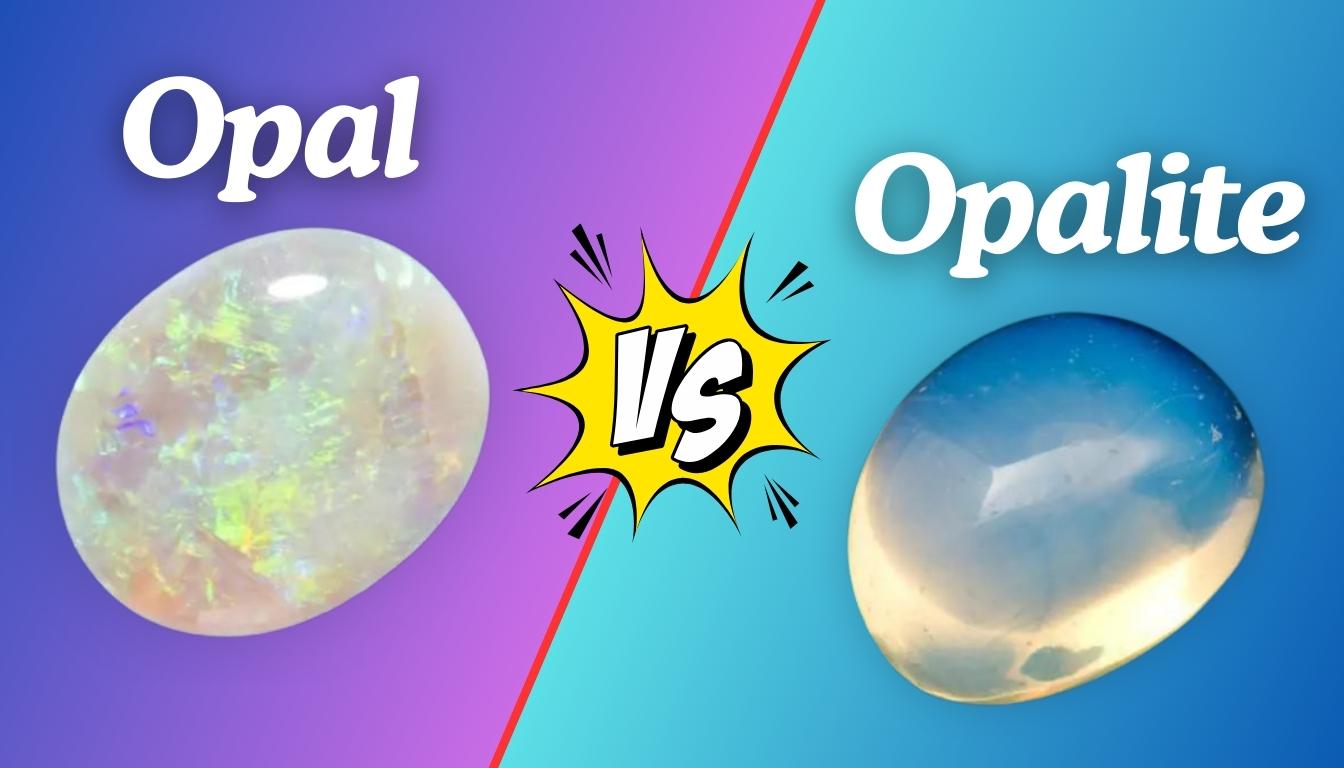Both opal and opalite are exceptionally lovely in their own right. They are so alike in sound and have some common features, but they could be opposite.
What makes opal different from opalite? How would you distinguish between them?
Opals are produced by nature in different varieties known as common opals (no color play) and precious opals (play of color). At first, Opalite was a synonym for Common Opal, though at present Opalite is more likely to refer to glass Opal Simulants.
The distinction between Opal vs. opalite, Some confusion can surround opalite. To understand how to distinguish these stones, we will discuss the specifics of each of these stones and the differences and similarities between Opal and Opalite.
Table of Contents
Opals: What Are They?

Opal is famous for its distinct and amazing spectral hues and plays of color. These are rare, valuable, and attractive mineraloids. They look like crystals but lack a definite crystal structure. Not all Opals have the iridescent qualities. Other forms, which are commonly known as Common Opals, have also been referred to as Natural Opalites. Dendritic Opal, a variety with tree-like inclusions, is one such example of a play of colorless Opals.
Indeed, it is quite interesting to know that Opals may contain up to 10% of water. This stone has a refreshing, relaxing, cleaning, and cooling energy. It is closely associated with the element of Water.. The Opal’s magical and crystal healing aspects are linked closely to the balancing and rejuvenating energy body. This crystal’s rainbow hue energy is beneficial to all chakras.
Opals are available in several colors including white opals, blue opals, brown opals, green opals, pink opals, purple opals, red opals, yellow opals, and black opals. Their luster is vitreous, greasy, and waxy. Their element is water and are transparent. Their Mohs hardness is 5.5 to 6.5.
Opalites: What are they?

The name Opalite is primarily given to glass Opal Simulants. Artificial stones that mimic natural opal but don’t have the same chemical makeup as the real thing are called opal simulates. However, the term Opalite does have some confusion related to it because sometimes people define natural common opals as opalite, which do not contain play of colors. These are Natural Opalites.
Since 1980 people have described a type of sparkling glass that is usually transparent as Opalite. They are usually milky-white or transparent showing a glowing effect known as Adularescence. People associate Opalite with the metaphysical effects of peace and tranquility.
Not only the beauty of this man-made stone’s creation is a symbol of new positive beginnings but also it generates positive and mood-elevating effects. This is due to the natural energetics of glass which present concepts of transparency vision, power, weakness, and sophistication.
Opalite Man Made is a glass-based simulant and does not compare to synthetic or lab-created Opals which are manmade but identical in chemical composition and metaphysical qualities as a natural Opal.
The common colors of opalites include White, Orange, Pink, Blue, Purple, and green. They are generally transparent and have Mohs hardness of 5 to 6.5.
Distinctions Between Opalite and Opal

When talking about the differences between opal and opalite, we shall refer to natural, valuable, and common opals as opal and glass simulant opal as opalite.
Source
Opal is an exquisite gemstone proclaimed for displaying a range of dazzling spectral colors collectively referred to as ‘fire’. Australia is the largest opal producer in the world, contributing about 95% of global opal production. Some of the world’s biggest opal deposits are found in countries such as Coober Pedy, Lightning Ridge, and Andamooka. These regions are famous for producing premium quality opals such as black from the Lightning Ridge and white and crystal from the Coober Pedy region. Another shaft supplier of this gemstone is Ethiopia which is now a major producer of opals through its recently discovered Welo opals which are known to be bright fiery and less expensive.
Mexico also produces fire opals which are predominantly sold in shades of orange, yellow, and red and therefore do not exhibit the play of colors that are characteristic of Australian opals, instead, they emit a warm, fiery hue. Brazil and Honduras and opal from the United States particularly Nevada are also available but are not as popular as Australian opal in the global market.
While Opalite is a ‘man-made’ gem in that its optical properties and structure make it look like an Opal without possessing the inherent qualities of an Opal gemstone. It is made by a process that involves the use of silicone and other materials to come up with a dazzling blend of opaque and translucent material that has the quality of a milky, bluish luster.
Yet, opalite enjoys a large demand in the jewelry market because of its aesthetic aspects and its artificial nature. Currently, it is mainly synthesized in laboratories with substantial production capacity, which are situated in China since the large-scale production of opalite is made possible in this area, resulting in the production of excellent-quality duplicates.
Contrary to naturally occurring opal that is formed over millions of years under very specific geological conditions, opalite can be made in a shorter duration of time, making it a synthetic and cost-effective substitute for those wanting to achieve a similar look of opal. Thus, opalite has no value or historic importance compared to natural opal, but it is very popular as an ornamental stone and decoration material for jewelry, miscellaneous, and even feng shui objects due to the splendid beauty of the stone.
Make-Up
It is therefore important to make a distinction between opal and opalite, as the two materials are characterized by stark differences in their chemical makeup and the processes by which they are formed. Studying the physical and chemical properties of natural opal reveals that it is a hydrated amorphous form of silica with H₂O content varying from 3% to 21% and on average Opal of 6% to 10% by weight.
It is the relatively high water content within the structure that, in combination with the specific organization of spheres of silica, results in the effect known as the play of color in an opal. The silica is deposited in an ordered manner and light when passes through the spheres displays the characteristic iridescence or “fire “that is associated with opal formation takes place in sedimentary basins through hydrothermal activity where silica-saturated water filters through rocks and solidifies over an extended period of time.
While opalite is a unique form of material, it isn’t a mineral that can be found in nature, but rather a product of modern technology. It is made out of glass with fused silica being its core base and the manufacturing of it tends to add some minerals and oxides to attain that opalescent look. Opalite reflects a kind of bluish or greenish opalescence but the variety of colors present are visible as they are in an opal. Its appearance does not come from the silica microspheres covering the glass like opal but rather from the diffraction of light in the glass interior.
This difference in make-up is a basis on which opalite comes close to replicating some properties of opal in terms of appearance, but the two are not of the same physical or even optically identical and do not exhibit the hardness or the rainbow of colors of opal. Although the manufacturing process along with opalite crystal may seem to be intricate, it is in fact superior for producing a number of different items because of the ability for manufacturers to manipulate the appearance of the stones and their uniformity making opalite a widely used economical substitute for ornamental stones.
Visual Deception
Specifically, the deception is realized through the look of opal and opalite based on which it may become really difficult for an inexperienced observer to differentiate the two. Natural opal is loved for its fire, this is the ability to display a spectrum of colors that is created by the way light is reflected and refracted through the structure of silica spheres within the stone. Opal shows various patterns of rainbows which can be differently positioned and differently constructed only when the stone is put into motion, thus offering aesthetic value to the opal.
However, Opalite is an artificial gemstone; nevertheless, it has been shaped to have the appearance of an Opal. It reflects a pale hue, opalescent, which has a blue or green hue, and it may be polished in that controlled manufacturing manner to mimic the beauty of the natural opal. However, the opalite does not have the mobility of colors and perspectives, which belong to the authentic opal. However, its sheen is normally a more subdued type and seems rather fixed in position.
Opalite is generally pale and uniformly colored throughout, and is often described as being similar in appearance to Tiffany stone or angel skin; it does not possess the internal structure and banded color patterns characteristic of precious opal. However, due to such differences, the visual appearance of opalite is compelling and well-adored as a substitute for natural opal, especially in the realm of jewelry since it allows the creation of visually magnificent jewelry products at considerably lower costs.
Uncommonness
Its rarity contributes to its value and demand, due to the rarity of opal and opalite in nature. Natural opal is scarce and is even scarcer when establishing classifications of opal that have intense play-of-color and complex figures. The creation of opal is a geological event that occurs over millions of years; only precious and rare gems consist of premium-quality opal. Australia, Ethiopia, and Mexico are some of the best producers, but even among them, it is notoriously difficult to obtain top-quality stones. This has a positive effect on the gemstone’s appeal and value since each opal is imperfect and has its own shades and designs.
On the other hand, opalite is not a rare gemstone in any sense of the word. It is a manufactured product that is synthesized in voluminous amounts and later used as a construction material and is primarily derived from fusing silica and other minerals. It has been deliberately created and is precisely managed and therefore man-made afforded more uniformity and does not require geological formation. Hence, opalite is easily obtained and cheaper than natural opal in the current world market.
While it can more or less resemble opal, its availability and the fact that it is a man-made product offer a mere imitation of natural opal and do not possess the qualities that a true opal possesses. This difference in rarity would make opalite a versatile and cheaper substitute to natural opal for decorative and jewelry uses, for those who simply want to get a stone that has that appearance without paying a hefty price.
Age
River opal and opalite mark the main difference in their formation age and conditions of formation. Natural opal is found to be a crystal or solid structure to develop in million years under certain geological phenomena. It forms in sedimentary settings in which the mineral-impregnated water containing silica enters seams and crevices of rock and discharges silicon dioxide globules that coalesce into layers. This process may take from several million up to several tens-million years and depends on the environment and the presence of suitable fluid-solutions containing silica.
The earliest opals are known to reach back to the age of the Cretaceous-Tertiary, which is about a hundred million years old in Australia. It is these very opals that have been shaped and conceptualized in prehistoric terms as if containing within themselves the reincarnation of Earth’s geology.
It is worth noting, however, that opalite is not a gem that has existed throughout the millennia; it is primarily manufactured today in relatively modern means of production. Opalite can be produced within hours or days as a synthetic made, which replicates both the appearance of the gems and the physical process by which opal is created through the fusion of silica and other materials. It is hilariously different from the natural, gradual formation of the original opal gemstone.
Therefore, it can rightly be said that opalite lacks the aspect of geologic history and age-related qualities of natural opal. Autumn’s Cyclone is a tribute to the creative genius of homo faber and the advancement in technology that provides a synthetic model to the beautiful opal which takes ages to form naturally. Hence, opal and natural opal represent the cross-section of geological ages while opalite is a reflection of modern-day manufacturing.
Resistance to Heat
The crystalline structures of natural opal and opalite determine the varying levels of heat resistance experienced between the two minerals. Natural opal which is composed of >3% water should not be exposed to high temperatures as it will tend to dry up. This is due to the heat sensitivity of the fluids within the opal where at high temperatures the water in the opal is well likely to evaporate thus causing the opal to dry up and may crack.
This loss of water can also somewhat reduce the so-called play of color and make it less spectacular in opals. Therefore, the use of these opal pieces and instruments should be avoided in environments with high temperatures and direct contact with sunlight.
Meanwhile, opalite is man-made and is mostly made of fused silica glass; and it has a better heat tolerance than natural opal. Nevertheless, opalite can crack or become damaged at higher thermal conditions, however, it does not possess water in its composition which natural opal does, and will not undergo dehydration. Although the material feels similar to opal, opalite is actually a type of glass, and hence susceptible to any rapid changes in temperatures, since this can lead to the formation of cracks. As a result, while opalite is more resistant to moderate thermal radiation than natural opal, both materials are to be handled with caution to prevent the negative effects of temperature variations on the product.
Value and Cost
Opal and Opalite have significant differences in terms of valuation and costing, primarily on the basis of origin, rarity, and utilization. The natural gemstone opal is precious in its own right and it is priced depending on color, clarity, pattern, and play of color or movement of color in opal. Top-quality opals, especially those sourced from the Lightning Ridge area, may cost thousands of dollars per carat because of the valuable color and scarcity of the gemstone.
Boulder opal, crystal opal, and white opal are also very popular but their values are higher and lower according to the iridescent color patterns. Due to the scarcity of fine opals, they possess high aesthetics and demand, and also due to the light play properties in the precious gemstones world they command high prices.
Opalite on the other hand is a relatively cheap, artificial substance produced to mimic natural opal gemstones. Its value is much less than genuine silk because it is a man-made fiber that can be produced on a commercial scale cheaply. Opalite is usually cheap given its price of affordability meaning that it can be used in fashion jewelry, decorative, and metaphysical products.
Opalite, on the other hand, while not biogenic, has a more uniform appearance and is considerably less expensive, a more affordable substitute to real opal for those who remain impervious to the bewitching call of opal. Therefore, while natural opal became an admired gem due to its rarity and mineralogical value, the numerous users captivated by their possibilities may find opalite stone engaging and quite cost-effective.
The most common natural opal variants range in price from $10 to $150 per carat, while the most costly variety, called black opal, can bring between $50 and $10,000 per carat. Opalite glass is much less expensive. It is offered by tumbled stone, which sells for $1 to $3 each stone, rather than by carat.
Color Variations Found in Nature
Many types of natural opal exhibit a color play. The colors of opal originate naturally on Earth. Opalite colors are mostly translucent or milky, with a peachy pink glow against a lighter background and a blue glow against a darker background. Additionally, depending on the illumination, it can display reflections of various colors.
Opal and Opalite Relative Similarities

There exist several parallels between natural Opal and artificial Opalite, notwithstanding their differences as stones. We can learn more about these stones and their similarities.
Hardness
Opal and opalite are frequently the same hardness and exhibit many similarities. On the MOH hardness scale, both are in the center. Typically, opal ranges from 5.5 to 6.5, while glass opal ranges from 5 to 6.5.
Luster
Luster is the visible outcome of light’s interaction with a mineral’s surface roughness. Opal and opalite often have similar lusters because they are both primarily vitreous and occasionally pearly. Natural opal usually has a vitreous or glassy sheen. Occasionally, they may also appear dull, shiny, waxy, resinous, or oily. Artificial Opalite is always bright and shiny.
Transparency
The transparency or clarity of opal and opalite can be comparable. The clarity of naturally occurring opals can vary, with stones appearing translucent, transparent, or opaque. The most prevalent types of glass optlite are transparent or translucent.
Correlated Chakras
Opal and Opalite are similar in that several of the same chakras connect them. All of the chakras are connected to opals with color play. The Chakras of the Throat, Heart, Third Eye, and Crown are primarily associated with opal. Opal and Opalite share healing powers and benefits since they share these chakras. Both gems can enhance spiritual and emotional development as well as communication.
Benefits from a Metaphysical Perspective
In addition to having many characteristics in common, opal and opalite both have certain distinctive metaphysical qualities. Generally calm, jovial, lighthearted, and optimistic, these stones have an energy that is helpful during periods of rebirth.
Birthstone
The official October birthstone is opal, and opalite is designed to resemble real opal, which is one similarity between these stones. People therefore call it an October birthstone.
(FAQs) about Opalite vs Opal
Q1. Is opal the same as opalite?
Both in the affirmative and negative. Opalite is a term used to describe a variety grouping of Common Opals, or genuine Opals. Since they are composed of opalescent glass, which differs from actual opals in both production and chemical makeup, they are typically not genuine.
Q2. Who should not wear opalite?
Zodiac signs of Sagittarius, Leo, Libra, Scorpio, or Cancer should not wear natural opal since these signs are incongruent with Venus and can have negative repercussions.
Q3. What does natural opalite look like?
People use the term “common opal” to distinguish natural opalite from glass opalite. When opal glass is placed against a dark background, it appears blue. When positioned against a light background, its milky white color takes on an orange or pink hue.
Q4. Is opalite a real crystal?
The opalite gemstone is a synthetic crystal made mostly of glass and resin, occasionally metal, that mimics the appearance of real opal. Like the semi-precious gemstone opal, there is also a naturally occurring opalite variant composed of silica and water.
Q5. Does opalite glow in the dark?
Opalite is a Man-made opalescent glass. Opalite glows a bright pink or blue when positioned against a black background.
Stay Tuned to Gems Tycoon for all gems-related articles.









